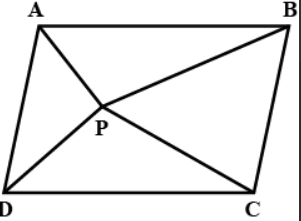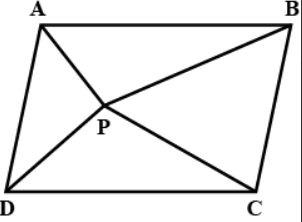Let P be a point interior to the acute triangle ABC. If PA+PB+PC is a null vector, then w.r.t traingel ABC, point P is its a. centroid b. orthocentre c. incentre d. circumcentreSolution in Tamil
centroid
orthocentre
incentre
circumcentre
The correct Answer is:a
→a−→p+→b−→p+→c−→p=0
or→p=→a+→b+→c3
Hence, P is centroid .
Topper's Solved these Questions
- DIFFERENT PRODUCTS OF VECTORS AND THEIR GEOMETRICAL APPLICATIONS BOOK - CENGAGECHAPTER - DIFFERENT PRODUCTS OF VECTORS AND THEIR GEOMETRICAL APPLICATIONS EXERCISE - Exercise
337 Videos
- DETERMINANTSBOOK - CENGAGECHAPTER - DETERMINANTSEXERCISE - All Questions
268 Videos
- DIFFERENTIAL EQUATIONSBOOK - CENGAGECHAPTER - DIFFERENTIAL EQUATIONSEXERCISE - Question Bank
7 Videos
Similar Questions
Find |→a|and∣∣→b∣∣, if (→a+→b)⋅(→a−→b)=8and|→a|=8∣∣→b∣∣.
View SolutionStatement 1: If bc+qr=ca+rp=ab+pq=−1, then|apapbqbqcrcr|=0(abc,pqr≠0). Statement 2: if system of equations a1x+b1y+c1=0,a2x+b2y+c2=0,a3x+b2y+c3=0 has non -trivial solutions |a1b1c1a2b2c2a3b3c3|=0
View SolutionFind the real value of m for which the subsititution y=um will transform the differential equation 2x4ydydx+y4=4x6 in to a homogenous equation.
View SolutionIn Figure, P is a point in the interior of a parallelogram ABCD . Show that ar(APB)+ar(PCD)=12ar(^(gm)ABCD) aR(APD)+ar(PBC)=ar(APB)+ar(PCD)

View SolutionLet P be a point interior to the acute triangle ABC. If PA+PB+PC is a null vector, then w.r.t traingel ABC, point P is its a. centroid b. orthocentre c. incentre d. circumcentre
View SolutionLet ABC be a triangle whose circumcentre is at P. If the position vectors of A,B,C and P are bar(a),bar(b),bar(c) and (bar(a)+bar(b)+bar(c))/(4) respectively then the positive vector of the orthocentre of the triangle is
View SolutionIn Figure, P is a point in the interior of a parallelogram ABCD. Show that ar(APB)+ar(PCD)=12ar (||gmABCD) ar (APD)+ar (PBC)=ar (APB)+ar(PCD)

View SolutionIf (a,b),(x,y),(p,q) are the coordinates of circumcentre,centroid,orthocentre of the triangle then
View SolutionLet ABC be a triangle whose circumcentre is at P. If the position vectors of A, B, C and P are →a,→b,→cand→a+→b+→c4
respectively, then the position vector of the orthocentre of this triangle is
View Solutionlet P an interioer point of a triangle ABC and AP,BP,CP meets the sides BC,CA,AB in D,E,F, respectively, Show that APPD=AFFB+AEEC.
View SolutionLet P be a point interior to the acute triangle ABC. If PA+PB+PC is a null vector, then w.r.t traingel ABC, point P is its a. centroid b. orthocentre c. incentre d. circumcentre
View SolutionLet P be a point interior to the acute triangle ABC. If PA+PB+PC is a null vector, then w.r.t traingel ABC, point P is its a. centroid b. orthocentre c. incentre d. circumcentre
View SolutionLet P be a point interior to the acute triangle ABC. If PA+PB+PC is a null vector, then w.r.t traingel ABC, point P is its a. centroid b. orthocentre c. incentre d. circumcentre
View SolutionIn Figure, ABC is an isosceles triangle in which AB=AC.andCP∣∣AB and AP is the bisector of exterior ∠CAD of ABC . Prove that ∠PAC=∠BCA and (ii) ABCP is a parallelogram.
View SolutionIn Figure, P is a point in the interior of a parallelogram ABCD . Show that ar(APB)+ar(PCD)=12ar(^(gm)ABCD) aR(APD)+ar(PBC)=ar(APB)+ar(PCD)
View SolutionIn a triangle ABC , let P and Q be points on AB and AC respectively such that PQ∣∣BC . Prove that the median AD bisects PQ.
View Solution
